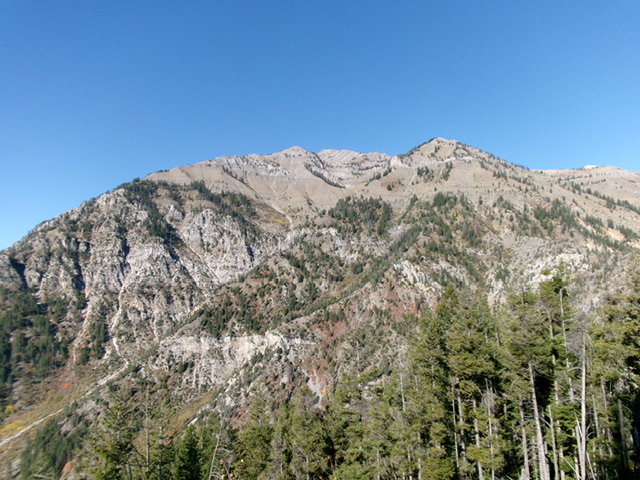Elevation: 9,953 ft
Prominence: 281

Climbing and access information for this peak is on Page 339 of the book. Livingston Douglas has provided more detailed information on the north ridge than you will find in the book. He also provided a new photo of the peak. The elevation and prominence figures have been updated based on the latest LiDAR measurements. Updated November 2024
Elkhorn Peak is an impressive, rugged bump on the southwest ridge of Mount Baird (10,029 feet). Its east and northwest aspects are rocky and quite rugged. The narrow, rocky ridge traverse between Elkhorn Peak and Mount Baird goes at Class 2. USGS Mount Baird

Elkhorn Peak (minor hump just left of center in distance) and Mount Baird (in dead center in distance) as viewed from the east. The prominent hump right of center is Point 9000+. Livingston Douglas Photo
North Ridge, Class 2 by Livingston Douglas
Access
Little Elk Creek Trail [(A)(3)(b)] as revised and updated. Please refer to the Mount Baird posting for an access update. The approach also includes climbing the northwest ridge on Mount Baird, then descending the south ridge on Mount Baird. Consequently, this climb begins at the Baird/Elkhorn saddle at 9,660 feet. This is the second leg of a 2-peak adventure that includes Mount Baird and Elkhorn Peak. It covers 12.5 miles with 5,600 feet of elevation gain round trip and requires a re-climb of Mount Baird on the descent.
The Climb
This climb is part of a ridge traverse from Mount Baird to Elkhorn Peak and back. When you view the north ridge of Elkhorn Peak from either the summit of Mount Baird or from Baird’s south ridge, it’s somewhat intimidating. You won’t believe that it’s a Class 2 scramble but it really is. The scramble begins at the Baird/Elkhorn saddle north of Elkhorn Peak. The north ridge is choppier than I expected, but it’s pure rock with no firs or vegetation to contend with.
Stay close to the ridge crest when climbing or descending this ridge. About halfway up, the ridge narrows and has a cliff band to block your way. To skirt this obstruction (as you ascend), simply drop 20 feet onto the east side of the ridge to access a gravelly chute that will lead you back up onto the ridge crest. During my ascent of the north ridge, I saw four mountain goats descending the northwest ridge of Elkhorn at a rapid pace, knocking out rocks as they scurried off. There were no elk horns on the summit. Sorry.
Additional Resources
Mountain Range: Big Hole and Snake River Mountains
Year Climbed: 1983
Longitude: -111.09749 Latitude: 43.35589